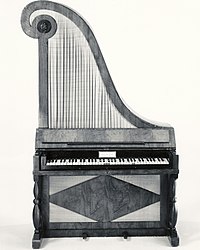
A harpsichord is a musical instrument played by means of a keyboard. This activates a row of levers that turn a trigger mechanism that plucks one or more strings with a small plectrum made from quill or plastic. The strings are under tension on a soundboard, which is mounted in a wooden case; the soundboard amplifies the vibrations from the strings so that the listeners can hear it. Like a pipe organ, a harpsichord may have more than one keyboard manual, and even a pedal board. Harpsichords may also have stop buttons which add or remove additional octaves. Some harpsichords may have a buff stop, which brings a strip of buff leather or other material in contact with the strings, muting their sound to simulate the sound of a plucked lute.
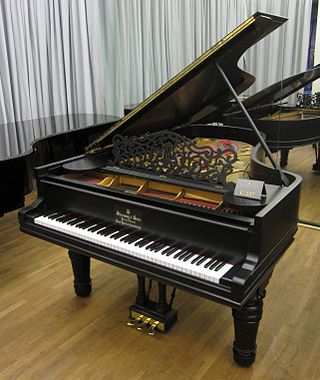
The piano is a keyboard instrument that produces sound when the keys are pressed. Most modern pianos have a row of 88 black and white keys: 52 white keys for the notes of the C major scale and 36 shorter black keys raised above the white keys and set further back, for sharps and flats. This means that the piano can play 88 different pitches, spanning a range of a bit over seven octaves. The black keys are for the "accidentals", which are needed to play in all twelve keys.

In musical instrument classification, string instruments or chordophones, are musical instruments that produce sound from vibrating strings when a performer plays or sounds the strings in some manner.
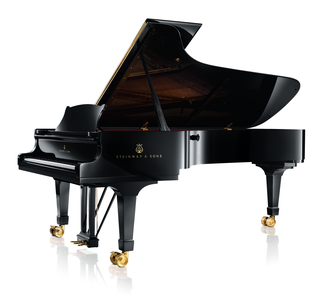
Steinway & Sons, also known as Steinway, is a German-American piano company, founded in 1853 in Manhattan by German piano builder Heinrich Engelhard Steinweg. The company's growth led to the opening of a factory in New York City, United States, and later a factory in Hamburg, Germany. The factory in the Queens borough of New York City supplies the Americas, and the factory in Hamburg supplies the rest of the world.
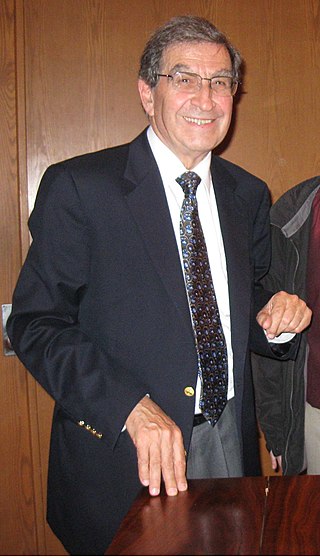
Malcolm Bilson is an American pianist and musicologist specializing in 18th- and 19th-century music. He is the Frederick J. Whiton Professor of Music in Cornell University, Ithaca, New York Bilson is one of the foremost players and teachers of the fortepiano; this is the ancestor of the modern piano and was the instrument used in Haydn, Mozart, and Beethoven's time.
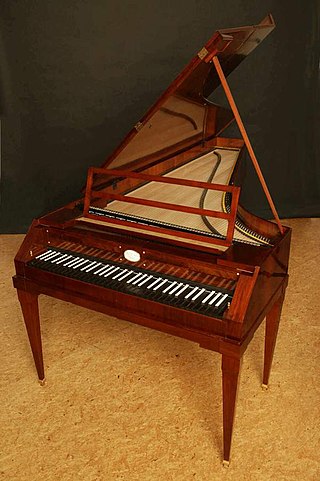
A fortepiano, sometimes referred to as a pianoforte, is an early piano. In principle, the word "fortepiano" can designate any piano dating from the invention of the instrument by Bartolomeo Cristofori in 1698 up to the early 19th century. Most typically, however, it is used to refer to the mid-18th to early-19th century instruments, for which composers of the Classical era, especially Haydn, Mozart, and the younger Beethoven and Hummel, wrote their piano music.

A harmonichord is a kind of upright piano in which the strings are set in vibration not by the blow of the hammer but by indirectly transmitted friction.

Gottfried Silbermann was a German builder of keyboard instruments. He built harpsichords, clavichords, organs, and fortepianos; his modern reputation rests mainly on the latter two.
The modern form of the piano, which emerged in the late 19th century, is a very different instrument from the pianos for which earlier classical piano literature was originally composed. The modern piano has a heavy metal frame, thick strings made of top-grade steel, and a sturdy action with a substantial touch weight. These changes have created a piano with a powerful tone that carries well in large halls, and which produces notes with a very long sustain time. The contrast with earlier instruments, particularly those of the 18th century is very noticeable. These changes have given rise to interpretive questions and controversies about performing earlier literature on modern pianos, particularly since recent decades have seen the revival of historical instruments for concert use.

The soft pedal or una corda pedal, is one pedal on a piano, generally placed leftmost among the pedals. On a grand piano this pedal shifts the whole action slightly to the right, so that the hammers, which normally strike all three of the strings for a note, strike only two of them. This softens the note and also modifies its tone quality. Tone quality is also affected by forcing the remaining two strings being struck to make contact with a part of the hammer felt which is not often hit ; this results in a duller sound, as opposed to the bright sound which is usually produced.

The pedal piano is a kind of piano that includes a pedalboard, enabling bass register notes to be played with the feet, as is standard on the organ.

Piano pedals are foot-operated levers at the base of a piano that change the instrument's sound in various ways. Modern pianos usually have three pedals, from left to right, the soft pedal, the sostenuto pedal, and the sustaining pedal. Some pianos omit the sostenuto pedal, or have a middle pedal with a different purpose such as a muting function also known as silent piano.

Finchcocks is an early Georgian manor house in Goudhurst, Kent. For 45 years it housed a large, visitor-friendly museum of historical keyboard instruments, displaying a collection of harpsichords, clavichords, fortepianos, square pianos, organs and other musical instruments. The museum was run by the owners of the house, Richard and Katrina Burnett until 2017. It is now owned by Neil and Harriet Nichols who use it as a family home and a venue for residential piano courses and classical concerts.
The Kirkman family were English harpsichord and later piano makers of Alsatian origin, active from the 1750s until the late 1800s.
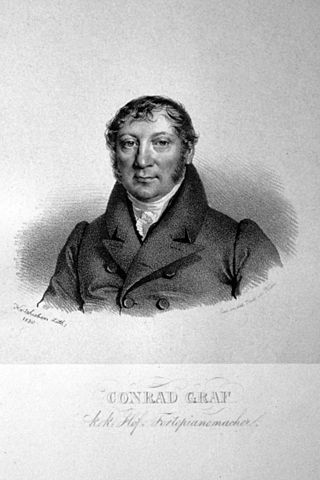
Conrad Graf was an Austrian-German piano maker. His pianos were used by Beethoven, Chopin, and Robert and Clara Schumann, among others.
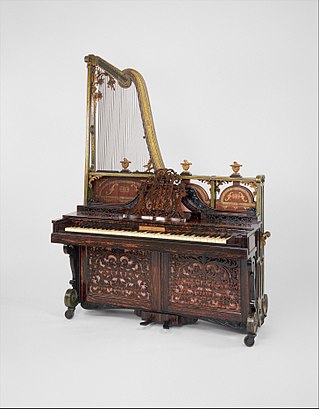
A euphonicon is a variety of upright piano.

Music technology is the study or the use of any device, mechanism, machine or tool by a musician or composer to make or perform music; to compose, notate, playback or record songs or pieces; or to analyze or edit music.

Mechanical music technology is the use of any device, mechanism, machine or tool by a musician or composer to make or perform music; to compose, notate, play back or record songs or pieces; or to analyze or edit music. The earliest known applications of technology to music was prehistoric peoples' use of a tool to hand-drill holes in bones to make simple flutes. Ancient Egyptians developed stringed instruments, such as harps, lyres and lutes, which required making thin strings and some type of peg system for adjusting the pitch of the strings. Ancient Egyptians also used wind instruments such as double clarinets and percussion instruments such as cymbals. In Ancient Greece, instruments included the double-reed aulos and the lyre. Numerous instruments are referred to in the Bible, including the horn, pipe, lyre, harp, and bagpipe. During Biblical times, the cornet, flute, horn, organ, pipe, and trumpet were also used. During the Middle Ages, hand-written music notation was developed to write down the notes of religious Plainchant melodies; this notation enabled the Catholic church to disseminate the same chant melodies across its entire empire.

Neo-Bechstein or Bechstein-Siemens-Nernst-Flügel were a set of electric grand pianos that were primarily built by Walther Nernst in the 1930s. Improvising upon an electrical prototype by Oskar Vierling, the design was executed around 1922, and the first of the set was marketed in 1931 to critical acclaim. The mechanics of the piano were implemented by the C. Bechstein company and the valve electronics were created by Siemens & Halske. The design belonged to a newer generation of electric pianos that eliminated the presence of any sound board.

Christian Ernst Friederici was a German builder of keyboard instruments. He is most known as a manufacturer of stringed keyboard instruments such as the Pyramidenflügel and the fortbien. He apprenticed under Gottfried Silbermann and Tobias Heinrich Gottfried Trost and from 1737, worked in Gera with his brother until his death. His instruments were owned by C.P.E. Bach and the Mozart family.
